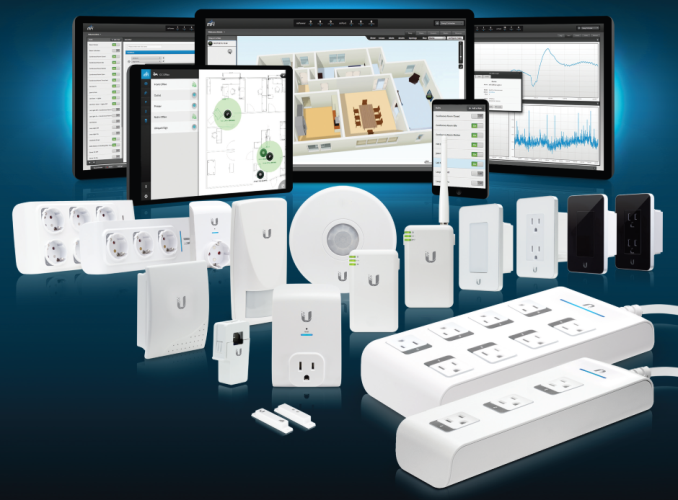Belkin WeMo and Ubiquiti mFi Home Automation Platforms Review
by Ganesh T S on April 27, 2015 8:00 AM EST- Posted in
- Home Automation
- Belkin
- Ubiquiti Networks
- IoT
Miscellaneous Aspects and Concluding Remarks
Home automation needs to be 'green'. Tracking the power consumption of battery-operated devices is challenging. However, we are only looking at AC-powered devices today. In order to do some evaluation. we connected the WeMo Insight Switch and mPower (3-port) to the two outlets of a mFi In-Wall Outlet. The instantaneous power consumption was tracked every second over a 5-minute interval for different situations and the results are tabulated below.
| Power Consumption Metrics Belkin WeMo Insight & Ubiquiti Networks mPower |
||
| Device | Notes | Average Power Consumption (W) |
| WeMo Insight | Relay Off | 1.44 |
| Relay On - No Load | 1.86 | |
| Relay On - 38W Load | 39.14 | |
| mPower | Relays Off | 0 |
| Relay On x1 - No Loads | 1.54 | |
| Relay On x2 - No Loads | 2.05 | |
| Relay On x3 - No Loads | 2.55 | |
| Relay On x3 - 38W Load x1 | 40.05 | |
The mPower consumes insignificant power to remain connected to the Wi-Fi network, while the Belkin Insight consumes an average of 1.44 W for this purpose. Turning on the relays ends up consuming power as shown above. Based on the above observations, Belkin can optimize the firmware and/or platform choice to give consumers a more power efficient product. The mPower consumes power within reasonable limits with the relays turned on. However, the AR9331 is by no means a low-power Wi-Fi SoC. It will be interesting to see the Wi-Fi SoCs used by Ubiquiti Networks in future iterations in this product space.
Interoperability is another aspect of home automation systems. While the WeMo is officially a closed platform, the reverse engineered aspects have made it possible for even the mFi controllers to control WeMo devices.
Earlier this month, we arrived at a set of points to ponder when dealing with any home automation system / device. Using those, we have come up with a summary table that provides essential information about the Belkin WeMo and the Ubiqiuiti Networks mFi at a glance.
| Home Automation Device Aspects - Summary Table | ||
| Aspect | ||
| Evaluated Devices | Light Switch Insight Switch |
mPower mPower Pro InWall Outlet InWall Dimmer Switch |
| Communication Technology | Wi-Fi (2.4 GHz) | Wi-Fi (2.4 GHz) |
| Platform | Ralink / MediaTek RT5350 1x1 802.11n Wi-Fi SoC Host CPU: MIPS 24KEc, DRAM: 32MB |
Qualcomm Atheros AR9331 1x1 802.11n Wi-Fi SoC Host CPU: MIPS 24Kc, DRAM: 32MB |
| Power Source | AC Powered | AC Powered |
| Hub / Bridge Requirement | No | No |
| Control Center | Local Device (basic access) Cloud (rules and scenes) |
Local Device (basic access, rules and scenes) Local Server (comprehensive access, rules and scenes) |
| User Control Interface | Mobile Apps | Web Browser Mobile Apps (basic control) |
| Open APIs | Yes (via Belkin's cloud servers) uPnP (local, limited, unofficial) |
Yes (uPnP, HTTP, SSH) |
| Third-party / Hub Compatibility | None advertised | None advertised |
| Cloud Reliance | Optional Reverse-engineered for local server / control capabilities |
None |
| Security Notes | Connects to Belkin's cloud servers Authenticates purely via SSID |
Username / Password Authentication LAN Access Only |
| User Support / Discussion Forums | WeMo Community | Ubiquiti Networks Community - mFi Forums |
| Street Price | USD 42 (Light Switch) USD 55 (Insight) |
USD 60 (mPower) USD 95 (mPower Pro) USD 59 (InWall Outlet) USD 59 (InWall Switch / Dimmer) |
Belkin has an awesome ecosystem of products with the WeMo - the only thing it needs to do to make the ecosystem more reliable and user-friendly is to allow consumers the option of disassociating completely from the cloud service. They need to release the WeMo cloud server program officially and allow it to run on a machine in the local network. While there are third-party unofficial solutions such as Mike's WemoManager and WemoServer, they are only trying to fix Belkin's shortcomings. We do agree that machine learning on a large scale from multiple users (particularly for the WemoWater that is yet to be released) is possible when everything goes through Belkin's cloud servers. However, the current state of the cloud service and the apps mean that users might be better off just having a local system-based solution to go with the WeMo hardware.
Coming back to the Ubiquiti Networks mFi lineup, the non-Wi-Fi-based mPort sensors may pose a challenge to install for the general audience. The building automation / enterprise focus of the mFi lineup is an acceptable excuse, though - consumers involved in those types of setups are usually professionals and understand the technology. That said, Ubiquiti Networks will be the first to admit that their product is not designed and/or marketed for the average consumer. This is a pity, because, under the rough exterior (lack of official apps, requirement of an on-premises home automation server for complex scenes and rules, lack of marketing etc.), we have a very flexible and open-source friendly home automation platform.
There are probably many home automation devices that are more open / open-source friendly and/or user-friendly compared to the Ubiquiti Networks mFi platform. However, we recommend mFi due to the following aspects:
- Pricing: The mFi modules may be cheap in terms of the retail prices, but the build-quality and reliability are enterprise-grade.
- Right balance of out-of-the-box readiness to deploy and end-user flexibility
- Security and privacy aspects handled well by avoiding the cloud
- Support and user forums: Developers have a major presence and respond to user feedback and bug reports promptly.
Belkin's WeMo is popular amongst consumers, but, even after 2 years in the market, they still have a lot to do in terms of delivering a consistent user-experience. On the other hand, the support software ecosystem for the Ubiquiti Networks mFi lineup needs to cater better to the non-tech-savvy consumers - However, that doesn't prevent us from recommending the Ubiquiti Networks mFi to the AnandTech audience.












41 Comments
View All Comments
metayoshi - Monday, April 27, 2015 - link
Wow. I'm surprised you guys are actually reviewing these products.I have one of those WeMo Switches myself (not the light switch and not the Insight, just the plain switch that has a power outlet). It's actually very convenient for me as I wanted a way to turn on and off my bedroom light without needing to walk in the dark, so I just found one of these at Best Buy, and I've been happy with it ever since. I originally thought I wouldn't use the remote features, but I actually have when, for example, both my girlfriend and I are out late, and we need to turn on the light for the cats.
However, I also agree that the Android app is sometimes inconsistent. Upon opening the app, sometimes my phone takes a while to connect to it, or it just doesn't find the WeMo switch at all. One thing I know is that the switch that I got is 2.4 GHz WiFi only, and my phone connects to my WiFi on the 5 GHz band, so I think it sometimes gets confused and doesn't connect right away. A close and re-opening of the app usually fixes that problem. Also, firmware updates are kind of annoying since the WeMo device has to power cycle itself, and it always reboots into a power off state, so doing a firmware update in the middle of the night when the light is still on is inconvenient.
Other than those annoyances though, I'm very happy with it. I can turn off the lights without fearing I might trip on something on my way to the bed or on my way to the light switch, and I can turn on the lights for the cats when I'm not home and it's getting dark. I don't think the products are for everybody, but I like my simple use case of it. I don't see myself getting anything fancier than the simple power outlet at the moment, but what I have was a worthwhile investment for me.
Byte - Tuesday, April 28, 2015 - link
I've been using a Belkin switch for about 2 years now and it needs to be repaired every quarter or so from bugs and updates can make it forget pairing. I use it to turn on the AC at work half an hour before I get in as it takes that long to cool the place down and really helps. But other than that fringe scenario, i really don't see much use in these switches.olafgarten - Tuesday, April 28, 2015 - link
Ubiquiti Products are really good, I use to use ruckus access points, but decided to give the unifi stuff a try, they outperformed the ruckus ones while still costing a fifth of the price.SunLord - Tuesday, April 28, 2015 - link
I'd personally would love it if you guys reviews a wink based system given it's large product selection from multiple vendorsbznotins - Tuesday, April 28, 2015 - link
I've been using the 3-plug mPower for a couple of years now (bought it back when AT did the first review) and it works great. Will have to investigate the light switches!zodiacfml - Tuesday, April 28, 2015 - link
I still don't know what these things try to solve. They seem added complexity for little benefit.I'd rather have a review of LED lighting.
I'm still thinking....but nothing came, but could be an opportunity for the first great idea though.
toyotabedzrock - Tuesday, April 28, 2015 - link
If they used a different type of relay they could eliminate the power drain.toyotabedzrock - Tuesday, April 28, 2015 - link
You should look at firmware updates, how hard will they be for end users?ganeshts - Wednesday, April 29, 2015 - link
That is a good point. I will add it to the comparison table in future reviews.Usually, the mobile apps handle the firmware updates after prompting the user - it is mostly a seamless operation (at least as far as the two product lines discussed here are concerned). The web UI for the Ubiquiti devices also allow the upgrade - that aspect is not a dumbed down procedure like what Belkin has done - but it should be familiar to anyone who has upgraded their router or NAS firmware.
Azurael - Wednesday, April 29, 2015 - link
Yum. Belkin network hardware. Sure to need rebooting several times a week and randomly refuse to talk to the device you're using at any given moment. Then, a 6 months later when massive security holes are uncovered in it, they'll refuse to update the firmware on the grounds of obsolescence. And it'll probably be full of holes in the first place (I love the way you can't actually disable WPS on most of the Belkin routers I've encountered. They often have a toggle in the management interface, but it does NOTHING!)Theire router hardware is okay when it's running something like OpenWRT or DD-WRT but I can't say I'd go out of my way to give money to them.